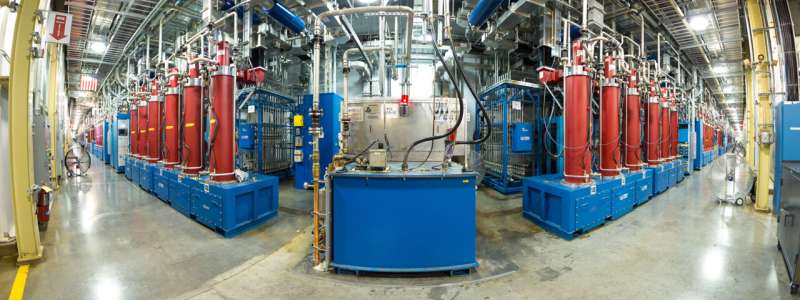This article has been reviewed according to Science X's editorial process and policies. Editors have highlighted the following attributes while ensuring the content's credibility:
fact-checked
trusted source
proofread
Spallation Neutron Source accelerator achieves world-record 1.7-megawatt power level

The Spallation Neutron Source at the Department of Energy's Oak Ridge National Laboratory set a world record when its particle accelerator beam operating power reached 1.7 megawatts, substantially improving on the facility's original design capability.
The accelerator's higher power provides more neutrons for researchers who use the facility to study and improve a wide range of materials for more efficient solar panels, longer–lasting batteries and stronger, lighter materials for transportation. The achievement marks a new operational milestone for neutron scattering in the United States and opens the door to tackling more difficult questions and problems in materials science research.
"This increase in beam power represents another milestone in the Proton Power Upgrade project, an essential component in enabling new science at the SNS, including insights into advanced materials for clean energy applications," said interim ORNL Director Jeff Smith. "I commend our staff for their efforts in accomplishing this new record."
Since construction was completed in 2006, the SNS has been a world-leading DOE Office of Science user facility that provides powerful advanced scientific capabilities for thousands of researchers from around the world to study energy phenomena and materials down to the atomic scale.
The facility produces neutrons by accelerating protons down a 300-meter-long linear accelerator, around an accumulator ring and into a liquid mercury target. Upon impact, a "spall" of neutrons is routed to surrounding research instruments, which enables scientists to study the atomic structure and behavior of various materials. Neutrons scatter off atoms within the material and are captured by high-speed detectors, revealing fundamental information for research teams to analyze.
A megawatt is a unit of measure of the beam power of a particle accelerator. The SNS' 1.7-megawatt power level was reached after the recent installation of additional accelerating systems, part of the ongoing Proton Power Upgrade project at the accelerator.
ORNL's Proton Power Upgrade will continue to push the particle accelerator's beam power up to 2.8 megawatts. This will increase the number of neutrons available for experiments at the existing First Target Station to enable new discoveries and power the planned Second Target Station, a complementary third neutron source at ORNL. STS will address emerging science challenges through experiments not currently feasible nor routine, with the ability to study smaller or less-concentrated samples or those under more extreme environmental conditions.
Besides SNS, ORNL is home to the High Flux Isotope Reactor. Completed in 1965 and operating at 85 megawatts, HFIR's steady-state neutron beam is the strongest reactor-based neutron source in the United States.
Provided by Oak Ridge National Laboratory





















